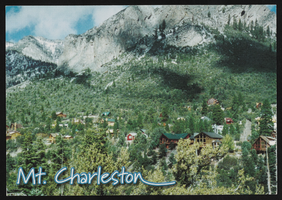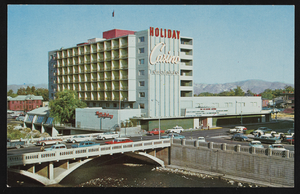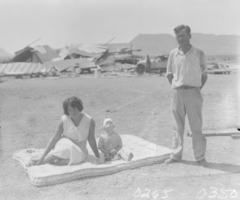Search the Special Collections and Archives Portal
Search Results

Film transparency of a ghost town, Delamar, Nevada, 1956
Date
1956
Archival Collection
Description
Some of the abandonded buildings in Delamar, Nevada. A tailing pile from one of the mines is visible in the center of the photograph. A stone structure is visible on the right side of the photograph. Delamar, Nevada, nicknamed The Widowmaker, is a ghost town in central eastern Nevada, USA along the east side of the Delamar Valley. During its heyday, primarily between 1895 and 1900, it produced $13.5 million in gold. In 1889, prospectors John Ferguson and Joseph Sharp discovered gold around Monkeywrench Wash. A mining camp was then born west of the Monkeywrench Mine. It was called Ferguson. In April 1894, Captain Joseph Raphael De Lamar bought most of the important mines in the area and renamed the Ferguson camp as Delamar. In the same year, a newspaper called the Delamar Lode began publication and a post office was opened. Soon, the new settlement boasted more than 1,500 residents, a hospital, an opera house, churches, a school, several businesses and saloons. Most buildings were made of native rock. By 1896, the Delamar mill was handling up to 260 tons of ore daily. Water for the camp was pumped from a well in Meadow Valley Wash, some twelve miles away. Supplies and materials traveled even further, by mule team over mountainous terrain from the railroad head at Milford, Utah, which was 150 miles from Delamar. Silicosis The gold in the Delamar mines was embedded in quartzite which when crushed created a fine dust. Miners breathing the dust often developed silicosis and the town became known as a "widow-maker." Many ruins now stand semi-intact in the Delamar ghost town region. Foundations can easily be seen from adjacent hills. There are two graveyards, which have been vandalized. The area is honeycombed with mines and mineshafts, but in recent years the main shaft has been blasted closed. Wild horses roam the area. The nearby dry lake is known to pilots as Texas Lake because its outline resembles the state of Texas.
Image
T-Shirt Color: Gray; Front: Lakeside Fire Dept. 1949-1999 50 Years of Service, Fire Emblem W/ Fire Equip; Back: Lakeside Fire Dept., Two Fire Engines; Handwritten Text: Solvay Way, approximately 2001-2012
Level of Description
File
Archival Collection
New York-New York Hotel and Casino 9-11 Heroes Tribute Collection
To request this item in person:
Collection Number: MS-00459
Collection Name: New York-New York Hotel and Casino 9-11 Heroes Tribute Collection
Box/Folder: Box 399
Collection Name: New York-New York Hotel and Casino 9-11 Heroes Tribute Collection
Box/Folder: Box 399
Archival Component
T-Shirt Color: Light Gray; Front: North Naples Professional Firefighters, IAFF Local 2297, Local Union Emblem; Back: North Naples Firefighters Local 2297 25 Years Of Service, Firefighter Carrying Child, approximately 2001-2012
Level of Description
File
Archival Collection
New York-New York Hotel and Casino 9-11 Heroes Tribute Collection
To request this item in person:
Collection Number: MS-00459
Collection Name: New York-New York Hotel and Casino 9-11 Heroes Tribute Collection
Box/Folder: Box 387
Collection Name: New York-New York Hotel and Casino 9-11 Heroes Tribute Collection
Box/Folder: Box 387
Archival Component
T-Shirt Color: White; Front: Local Dept. Emblem W/ Fire Equipment; Back: Comptche Volunteer Fire Dept. 1964-1994, 30Years Of Service, Firefighter Holding Ax & Hose W/ Fire Truck In Background & House, approximately 2001-2012
Level of Description
File
Archival Collection
New York-New York Hotel and Casino 9-11 Heroes Tribute Collection
To request this item in person:
Collection Number: MS-00459
Collection Name: New York-New York Hotel and Casino 9-11 Heroes Tribute Collection
Box/Folder: Box 360
Collection Name: New York-New York Hotel and Casino 9-11 Heroes Tribute Collection
Box/Folder: Box 360
Archival Component
T-Shirt Color: Black; Front: Chicago Police 17th District Gang Team, Dept. Emblem; Handwritten Text: One Year Later We Still Stand Behind Our NY Brothers 9/24 - Signatures, approximately 2001-2012
Level of Description
File
Archival Collection
New York-New York Hotel and Casino 9-11 Heroes Tribute Collection
To request this item in person:
Collection Number: MS-00459
Collection Name: New York-New York Hotel and Casino 9-11 Heroes Tribute Collection
Box/Folder: Box 311
Collection Name: New York-New York Hotel and Casino 9-11 Heroes Tribute Collection
Box/Folder: Box 311
Archival Component

Mt. Charleston in Nevada: postcard
Date
1940 (year approximate) to 1990 (year approximate)
Archival Collection
Description
From the Harvey's Hotel and Casino Postcard Collection (PH-00367) -- Mt. Charleston, Nevada. In the Spring Mountain Range NW of Las Vegas (316,000 acres). Fifty miles of hiking trails. Highest Peak: Mt. Charleston at 11,918 feet above sea level. Highest residential area is at 8,000 ft. Pictured is "Echo View subdivision."
Image
Nevada Women’s Conference Photograph Collection
Identifier
PH-00069
Abstract
The Nevada Women’s Conference Photograph Collection depicts the statewide women’s conference held in June 1977 in Las Vegas, Nevada. The photographs include keynote speaker Gloria Steinem, event organizers, workshops, volunteers, and musical performances.
Archival Collection

The Holiday Hotel in Reno, Nevada: postcard
Date
1940 (year approximate) to 1990 (year approximate)
Archival Collection
Description
From the Harvey's Hotel and Casino Postcard Collection (PH-00367) -- The Holiday Hotel in Reno, Nevada. Reno's newest and most modern hotel, situated directly on the banks of the Truckee River, Reno, Nevada.
Image

Film transparency of tornado victims, Nevada, 1931
Date
1931
Archival Collection
Description
From left to right, tornado victims Mrs. Joe Leavy, three-year old (Baby) Bell, and what is presumed to be Joe Leavy in Midway City, Nevada. Midway City, now known as Henderson, is located eight miles out of the Hoover Dam highway.
Image

Film transparency of tornado victims, Nevada, 1931
Date
1931
Archival Collection
Description
From left to right, tornado victims Mrs. Joe Leavy, three-year old (Baby) Bell, and what is presumed to be Joe Leavy in Midway City, Nevada. Midway City, now known as Henderson, is located eight miles out of the Hoover Dam highway.
Image
Pagination
Refine my results
Content Type
Creator or Contributor
Subject
Archival Collection
Digital Project
Resource Type
Year
Material Type
Place
Language
Records Classification
